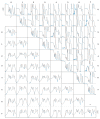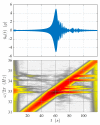Experimental Investigation on a Bladed Disk with Traveling Wave Excitation
- PMID: 34201402
- PMCID: PMC8229122
- DOI: 10.3390/s21123966
Experimental Investigation on a Bladed Disk with Traveling Wave Excitation
Abstract
Bladed disks are key components of turbomachines and their dynamic behavior is strongly conditioned by their small accidental lack of symmetry referred to as blade mistuning. The experimental identification of mistuned disks is complicated due to several reasons related both to measurement and data processing issues. This paper describes the realization of a test rig designed to investigate the behavior of mistuned disks and develop or validate data processing techniques for system identification. To simplify experiments, using the opposite than in the real situation, the disk is fixed, while the excitation is rotating. The response measured during an experiment carried out in the resonance-crossing condition is used to compare three alternative techniques to estimate the frequency-response function of the disk.
Keywords: bladed disk; system identification; traveling wave.
Conflict of interest statement
The authors declare that the essay serves no personal or organizational interest. The authors declare no conflict of interest.
Figures









References
-
- Rao J.S. Turbomachine Blade Vibration. 1st ed. New Age International Publisher; New Delhi, India: 1991.
-
- Srinivasan A.V. Flutter and resonant vibration characteristics of engine blades. J. Eng. Gas Turbines Power. 1997;119:742–775. doi: 10.1115/1.2817053. - DOI
-
- Sinha A. Vibration of Nearly Periodic Structures and Mistuned Bladed Rotors. 1st ed. Cambridge University Press; Cambridge, UK: 2017.
-
- Martel C., Corral R. Asymptotic description of maximum mistuning amplification of bladed disk forced response. J. Eng. Gas Turbines Power. 2009;131:022506. doi: 10.1115/1.2968868. - DOI
-
- Rivas-Guerra A.J., Mignolet M.P. Maximum amplification of blade response due to mistuning: Localization and mode shape aspects of the worst disks. J. Turbomach. 2003;125:442–454. doi: 10.1115/1.1506958. - DOI
LinkOut - more resources
Full Text Sources

